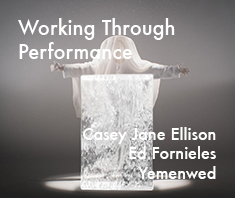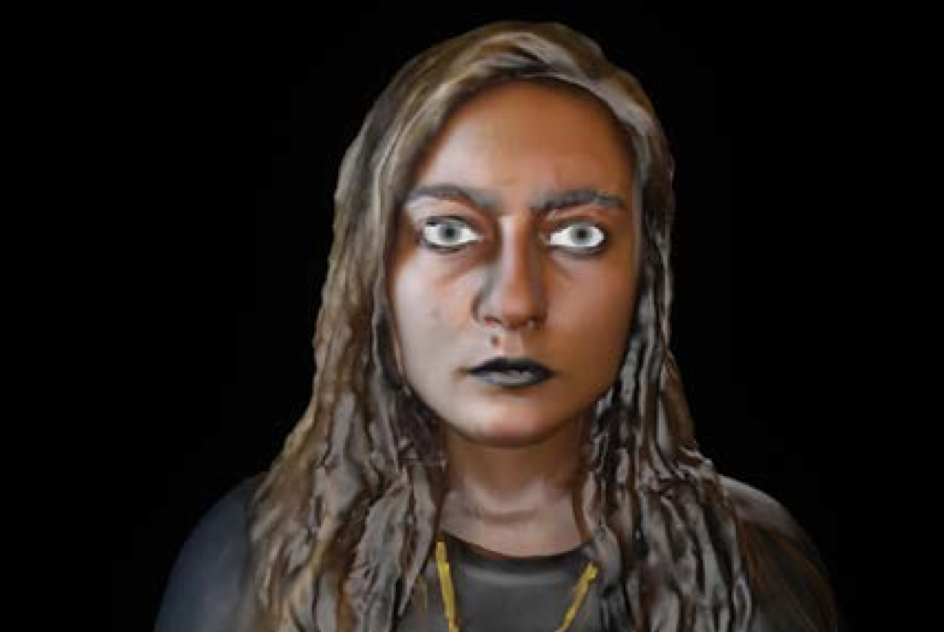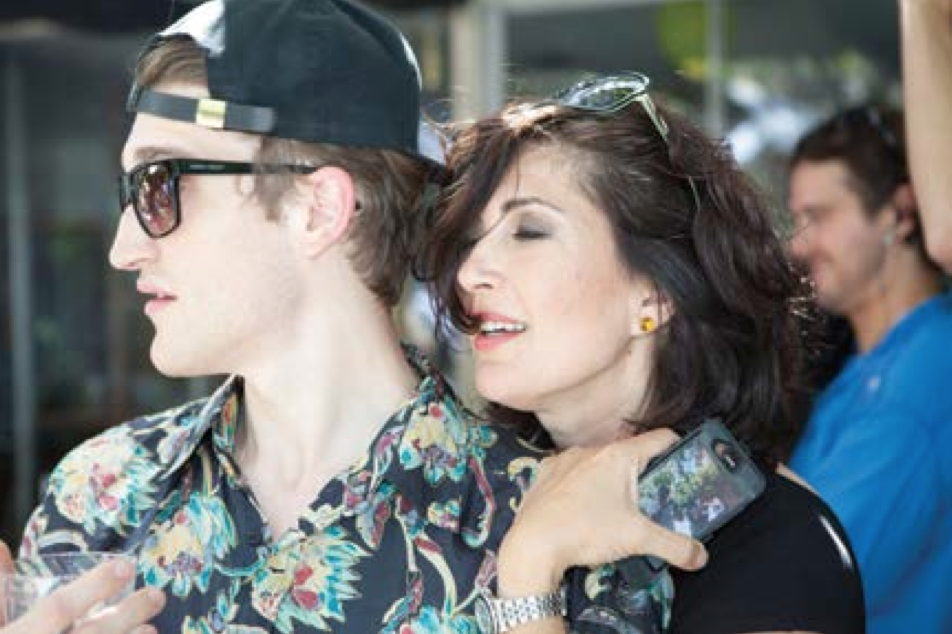Working Through Performance
Casey Jane Ellison, Ed Fornieles, and Yemenwed
By Courtney Malick

Casey Jane Ellison, “It’s So Important To Seem Wonderful,” (2012), video still. Courtesy of the artist.
Since we are now forty-something years into the history of performance art, it is rather obvious to discuss the medium as body-centric, time-elapsing, spatially-oriented and generally speaking, for the “here and now.” And while there are still performance artists whose work fits this description in ways that continue to be thought provoking, like most things “contemporary,” there has also begun within the last ten years or so, an evident split in the road of performance. This split has taken many forms that have lead artists to consider performance as an essential and integral element that is incorporated into their practices, but often in ways that have nothing to do with the body in terms of corporeality, nothing to do with real time or space, and even less to do with an audience that must necessarily be present in the moment. In that sense, such artists are working through the craft of performance, taking the tangibility that performance art initially clung to as a way to thwart the art market, and replacing it with something altogether unfixed, interchangeable and malleable. This is significant because currently what is unfixed is in fact often more relevant to ways audiences relate to art than trying to pin a singular performance to a specific time, place and set of actions.
Such artists, not surprisingly, often use their laptops, iPads and iPhones like studios. Since it is action, characters and dialogue that they take as raw materials, this kind of integrated performance art is wrought through technological systems of modification and communication rather than the performance of the 1970s and ‘80s that was de- pendent upon site specificity. From sociology, behavioral studies and the like, we know that performance art is inherently linked to human behavior, as everyone performs to some extent in their daily lives. Therefore, now that so much of our lives are lived virtually, these new directions in performance art are enhanced by and embedded into digital and social circuits such as YouTube, Facebook, Twitter, Vimeo, Photoshop, etc.
Furthermore, such work often emulates or projects the ways in which these kinds of systems (that we at this point take for granted), have reconfigured how we see, communicate, and piece together information within a sped up and ever-shifting set of layered screens at our fingertips.
While many artists in the past may have considered themselves to be installation, new media, video artists or photographers, we continue to see that much of their work shares a backbone of performance that is more about acting and directing than it is about emotion or self expression. Acting is often key, and furthermore, such innovative performance-based artists also adapt the formats of their work to mimic those that are traditionally designated for actors, such as movies, webisodes, soap operas, reality TV, musicals, crime dramas – and even stand up comedy. Such work relies entirely on directors and performers, and their ability to shape-shift. However, it is important to note that through this way of working its performative crux is often manipulated over and over again to produce various iterations that at times look and function differently from one another while remaining the same in tone and content, creating a conceptual constellation rather than a singular work of art.
Three of such exciting young artists are Casey Jane Ellison, Ed Fornieles (both based in Los Angeles), and the New York-based collective Yemenwed. While these three artists’ work are clearly distinguishable, they nonetheless speak to one another in a language that has abandoned the visceral root of early performance art in favor of performative and theatrical work that usually involves an initial, somewhat narrative, live action, with or without an audience, that functions more like a rehearsal than a true ‘performance,’ coupled with any number of video, installation, still image, collage or animated versions, additions or addendums.
CASEY JANE ELLISON
Ellison is originally from Los Angeles, and after spending some time in New York follow- ing art school at the Art Institute of Chicago, she has recently returned to L.A. Over the past few years, her work has progressed into the development of an iconic persona through a variety of media that includes stand-up comedy, 3D animation, holographic photography and robotic representations of herself. Though Ellison has been working in video and animation longer than she has been doing stand-up, she has surprisingly and rather successfully begun to fuse the two, allowing one to inform the other in a loop that allows her practice to take on both live and digital forms. At times the two modes literally overlap, creating a confusing and unusual doubling effect. This occurred during her live stand-up act at MOCA in December 2012, when Ellison, mic in hand, performed the routine she had previously recorded as the audio track that accompanied her video, “It’s So Important to Seem Wonderful” (2012), which was screened directly following her performance. “It’s So Important…” features an animated, bald, mechanical looking avatar of the artist doing her act with the void of the Internet as her audience.
Like many comedians, Ellison’s humor often stems from the kinds of dark and self loath- ing corners of collective consciousness that cause most people to develop weird ticks, habits or addictions. In “It’s So Important…” Ellison’s robotic (and admittedly tipsy) avatar uses her complaints about her own body and image as the butt of her jokes. She then immediately deflects them off, making her (at times) virtual audience feel as awkward as the scenarios she recounts. In one such anecdote the robot poses a scenario to the audience, wondering if they can relate as she describes, “hating your body so much that you rip framed pictures off the wall and smash them onto the ground, and then take the shattered glass and start stabbing the air.”
Like many artists working in this vein, character formation and documentation are fundamental to the development of Ellison’s persona. Self-documentation is central to many artists who utilize either their own or a cast of performers’ acting as the base for a project and then work off of that footage in various ways. In this sense, documentation becomes a medium in and of itself to a certain extent, and serves as both a major constituent to a work as well as its own referent retrospectively. It is also this initial documentation that allows for so much more experimentation and manipulation of performances through post-production, which is where much of the aesthetic of her work is developed. For Ellison, a project like “It’s So Important…” includes an animated video, a recording of one of presumably many takes of that particular stand up routine, and the script for the routine itself, which is also porous in its ability to be re-worked. In this way, the confluence of each of these elements is again, unfixed, and allows for further iterations and interventions.
Click to watch Casey Jane Ellison’s “It’s So Important To Seem Wonderful”
ED FORNIELES
Born and educated in London, Ed Fornieles recently moved to Los Angeles where he has continued his category-defying practice of fast-paced, young things acting out all kinds of antics and inner-office politics with that all too familiar brand of true-yet-vapid reality TV drama. Fornieles, is clearly fucking with ways that the Internet can disseminate, highlight and perpetuate a particular kind of cloying performativity. Playing out a sitcom via a cast of constructed profiles or “bots” Fornieles’ collaborative Inter- net-performance project with Lucy Chinen, “Maybe New Friends” (2013), was presented in conjunction with American Medium, a “multimedia exhibition platform,” and is just one of the many tricks up his sleeve. Fornieles uses such interventions to present the idea of acting out an alternate sense of reality in ways that cleverly slip directly into the lives of those of us communicating and working on approximately 5-10 intersecting digital platforms or networks at any given moment on a minimum of 2 screens/devices simultaneously.
“Maybe New Friends” is undeniably a heavily orchestrated performance, yet it takes place exclusively on Facebook, Twitter, Instagram, and Viddy. His character’s “bot” “aggregates hundreds of accounts that fit a character profile.” Each character is comprised of a mixture of tweets taken from real Twitter accounts that are then coded, aggregated and filtered to create a unified voice. Such ensemble projects that involve casting, scripts, character development, costumes, etc. also contribute to this more theatrical form of performance art that does not distinguish between performance and acting in the clear cut ways that were important at the medium’s inception. Instead, projects like “Maybe New Friends” are useful precisely because they confuse such borders.
In Fornieles’ most recent video-performance, “Pool Party” (2013), another cast of young, L.A. twenty-somethings come together for the main character, Courtney’s, birthday, graduation… it’s not quite clear. In any case she is outspoken about her own celebration of herself and the quintessential bitchiness ensues. “Pool Party” is a twenty-four minute video that is the result of over eight hours of taping that Fornieles directed and shot with three camera crews, which are visible in the background of some of the scenes — only adding to its low-budget, reality TV tone, despite the grainy 8mm, Instagram-inspired film quality filters that were added in post-production. During the party, which is clearly supposed to be fun but is looming with bad vibes from the very beginning, lovers kiss and quarrel, women insult each other and laugh it off, drinks are poured, consumed and re-mixed, and Courtney’s oddly young looking, “old Hollywood” attired parents arrive. Soon Courtney’s “real Mom,” as she is repeatedly referred to, is sneaking to the bathroom to inject her lips and crow’s feet with a syringe, a sequence of outfit changes and drug-taking occurs, and eventually an innocent enough girl is ganged upon and slathered in blood. In the end the video, whose title implies a good ole’ time, leaves viewers with a sick feeling, like an overdose of narcissism combined with the disturbing long-term effects of reality TV and incessant selfie-taking.
Click to watch Ed Fornieles’s “Pool Party”
YEMENWED
Yemenwed, which includes six core members but can include ten or more collabo- rators, depending on the project, first formed in 2006. In 2008 they produced their first video, “Episode 3″, whose premise is based on one character’s journey through the digitized and enlarged surfaces of one of former founding member, Gloria Maximo’s paintings. Yemenwed, more so than Ellison or Fornieles, fully embodies the kind of theatricality with which much recent performance art has been imbued. Through their collectivity, they are able to create entire environments, both actualized and virtual, that incorporate costumes, functioning sets/installations, original scores, lighting, interactive video projections and intricate choreography. While each of their elaborate projects take on different social issues in strikingly abstracted ways, they continue to mirror the complex interconnectivity of social media and technology by weaving live performance documentation with post-production manipulations, that are then re-projected in tandem with later iterations of the same performance. In this way, like so many artists working through performance, Yemenwed’s end product is often a shifting of contexts with a constant motion and structure set in place by its signature choreography and impeccably designed sets and sculptures.
Yemenwed’s ability to stitch together so many interlocking constituents also leaves a great deal of room within their work for the kind of interchangeability that makes these new, unfixed forms of performance art that we are seeing today so intriguing. Through these methods they delve into social issues such as, insiders vs. outsiders in metropolitan cities with their first live performance project, “Bedroom w TV and Woman Lays w Aide” (2009), which takes a sculptural version of the large housing projects in lower Manhattan as its setting. In their next performance, “Woman Merges w Car” (2010), they explore gender roles and a mechanized, futuristic view of femininity. Through their use of post-production manipulations, one of the three videos that represents “Woman Merges w Car”, Yemenwed presents a minimalist, vehicular bathroom and bodily movements that combine grooming and personal hygiene with repetitive, impersonal office duties, through which the three women performers transform from human women into one conglomerate, automated force.
Yemenwed’s most recent video, which has not yet been performed live, is titled, “The Source” (2012). Here they hark back to a theatrical shtick that they used in their 2011 performance “No Image”, (which includes versions 1, 2 and 3), in which a block of ice, (then a real melting mess, this time a virtually rendered, glimmering cube), is cast as the narrator. In “The Source”, the ice cube jokingly tells his woes of being replaced in other artistic projects by crystals or glaciers. Ice’s voice is strangely similar to that of the Chef on South Park, and his tidbits of advice to young artists hoping to “break on through” are about as stereotypical. Interestingly, the video, like much of Yemenwed’s work, becomes advertently self-reflexive when Ice begins to talk about his previous experiences collaborating with the collective. In some ways this focus on dialogue is a departure for Yemenwed, whose signature early performances were expressed purely by intensely rehearsed and perfectly timed choreography that was created specifically for their commissioned musical scores. “The Source” does, however, also include a fanciful solo dance sequence at both its beginning and end, which is meant to signal the turning on and off of Ice’s moment in the spotlight. As always, Yemenwed continues to produce real costumes that incorporate unusual items and virtual sets and objects that create an otherworldly environment within which their characters thrive.
Click to watch Yemenwed’s “The Source”
This essay has been selected from SFAQ Issue 15.
For more information on each artist, visit:
Casey Jane Ellison | caseyjaneellison.com
Ed Fornieles | http://edfornieles.com/front2.html
Yemenwed | http://yemenwed.com
For previous SFAQ articles from print, visit:
–SFAQ Review: Dora Budor’s “Action Paintings” at 247365, Brooklyn, New York
-SFAQ Review: The Whitney Biennial, 2014
–SFAQ Review: Los Angeles Art Fairs 2014 – Art Los Angeles Contemporary and Paramount Ranch








